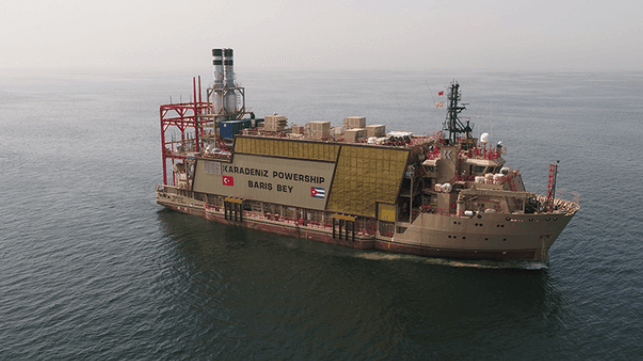 Image courtesy Karpowership
Image courtesy KarpowershipFrom Maritime Executive
The government of Cuba faces tough choices in addressing a chronic shortage of electrical generating capacity, as rolling blackouts have affected communities across the country for months.
The erratic power supply has added to the downward pressure on Cuba's economy, which has been in severe decline - so severe that about two percent of the population tried to leave for the U.S. last year.
The broader issue of economic malaise will be difficult to address, but Havana has at least found a technical way to reduce the impact of the power shortage: floating mobile generating stations, courtesy of Turkish operator Karpowership.
Cuba's relationship with Karadeniz-owned Karpowership began in 2018, when its government signed a four-year charter for three small floating power plants.
Taken together, these units provide about 110 MW of capacity.
As the Cuban utility sector's Cold War-era permanent power plants have deteriorated, Karpowership's share of the nation's grid capacity has gradually gone up.
Karadeniz Powership 'Irem Sultan' with the GeoGarage platform (GeoCuba nautical raster chart)
The eighth unit in Cuba arrived in Havana at the beginning of February, bringing total capacity to roughly 770 MW, or one-quarter of Cuba's minimum electrical demand of 3,000 MW.
The speed of delivery of a powership lends itself well to Cuba's needs.
Cuba's onshore power plants need deep maintenance, and the rapid addition of portable generating capacity makes it easier to take existing plants offline for overhaul.
It's also far faster than building new capacity on shore, which could take years and would require overcoming the structural hurdles to all infrastructure projects in Cuba - like U.S. sanctions and access to capital, among others.
The same obstacles may make it hard for Cuba to pay for the services of Karpowership, according to Al-Arabiya.
"The Cubans do not have any money," said Jorge Pinon, a senior research fellow at UT Austin, in conversation with the outlet.
Cuba's heavy dependence on oil for power generation is partly a quirk of Cold War history.
The Caribbean nation was a Soviet client state for decades, and it built out most of its power generation capacity to run on subsidized Russian fuel oil.
With the collapse of the Soviet Union, this relationship ended, and it has struggled to maintain and fuel its fleet of Eastern Bloc-designed thermal power plants ever since.
Under other circumstances, the nation might have become less reliant on fossil fuels.
Towards the end of the Cold War, Cuba nearly built an 880 MW nuclear power station with Soviet assistance.
Construction began in 1983, but the dissolution of the Soviet Union put an end to Russian financing and technical assistance.
The project was abandoned in 1992, and the ruins of the unfinished plant are still visible today.
The speed of delivery of a powership lends itself well to Cuba's needs.
Cuba's onshore power plants need deep maintenance, and the rapid addition of portable generating capacity makes it easier to take existing plants offline for overhaul.
It's also far faster than building new capacity on shore, which could take years and would require overcoming the structural hurdles to all infrastructure projects in Cuba - like U.S. sanctions and access to capital, among others.
The same obstacles may make it hard for Cuba to pay for the services of Karpowership, according to Al-Arabiya.
"The Cubans do not have any money," said Jorge Pinon, a senior research fellow at UT Austin, in conversation with the outlet.
Cuba's heavy dependence on oil for power generation is partly a quirk of Cold War history.
The Caribbean nation was a Soviet client state for decades, and it built out most of its power generation capacity to run on subsidized Russian fuel oil.
With the collapse of the Soviet Union, this relationship ended, and it has struggled to maintain and fuel its fleet of Eastern Bloc-designed thermal power plants ever since.
Under other circumstances, the nation might have become less reliant on fossil fuels.
Towards the end of the Cold War, Cuba nearly built an 880 MW nuclear power station with Soviet assistance.
Construction began in 1983, but the dissolution of the Soviet Union put an end to Russian financing and technical assistance.
The project was abandoned in 1992, and the ruins of the unfinished plant are still visible today.
Planta Nuclear de Juraguà with the GeoGarage platform (GeoCuba nautical raster chart)
Links :


No comments:
Post a Comment